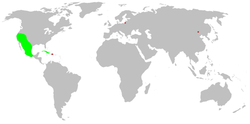Plectreuridae
| Plectreurid spiders Temporal range: Middle Jurassic - Holocene, 164–0 Ma |
|
|---|---|
 |
|
| Male plectreurid | |
| Scientific classification | |
| Kingdom: | Animalia |
| Phylum: | Arthropoda |
| Subphylum: | Chelicerata |
| Class: | Arachnida |
| Order: | Araneae |
| Infraorder: | Araneomorphae |
| Family: |
Plectreuridae Simon, 1893 |
| Genera | |
| Diversity | |
| 4 genera, 33 species | |
 |
|
†Eoplectreurys
Kibramoa
Plectreurys
Plectreuridae, sometimes called plectreurid spiders, are a small spider family confined to the Southwestern United States, Mexico, and the Caribbean. Only two living genera are known - the nominate genus Plectreurys and Kibramoa. In the past, the family was more widespread, with the Jurassic genus Eoplectreurys known from China, the Eocene Palaeoplectreurys baltica from Baltic amber and the Miocene Plectreurys pittfieldi from Dominican amber.
These ecribellate (lacking a plate-like woolly silk-producing structure anterior to the spinnerets on the venter), haplogyne spiders build haphazard webs under rocks and dead cacti. Adult males can be found wandering at night. Relatively little is known of their biology. Unlike the sicariids, scytodids and diguetids, to which they are most closely related, they have eight eyes. In appearance females of Plectreurys resemble those of the larger species of the cribellate Filistatidae. They differ in their eye arrangement and in having the first femora (third leg segment from the body) bowed.
†Eoplectreurys Selden & Huang, 2010
Kibramoa Chamberlin, 1924
...
Wikipedia
